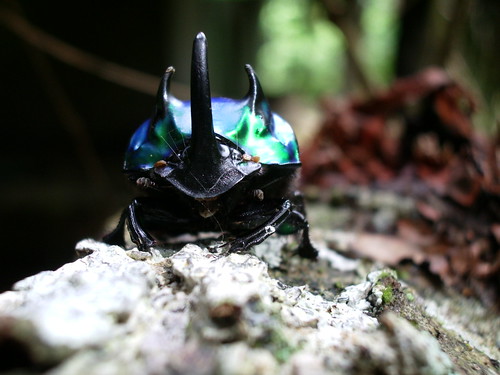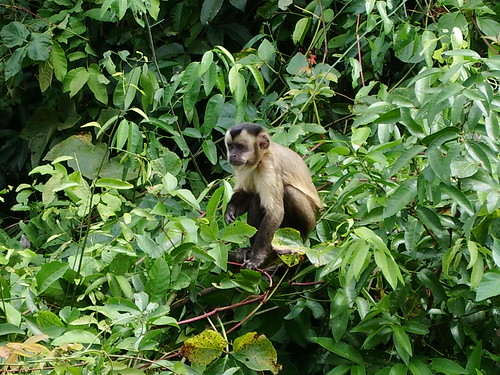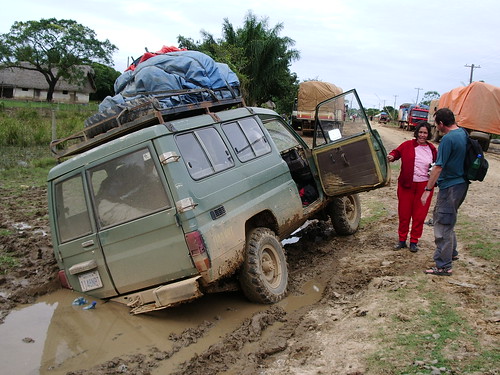See our photos from Rurrenabaque
A tiny, 12-seater plane swept us to the town of Rurrenabaque in the Amazon basin. The views were spectacular as we dodged the Andes mountain range and flew over dense jungle. Three guys at the front of the plane filmed the journey, unwittingly knocking the pilots headset off a few times with their camera lens.
Every gust of wind tossed the plane around and soon we were amidst thick cloud. How does the pilot know where the mountains are? Will we crash land in the jungle and end up eating each other, like in that film Alive? After 15 minutes of dense, milky mist, the pilot saw a break in the clouds and made a dive for it. We touched down on a field in the jungle. An old man raced out waving two fluorescent batons to direct the plane, but managed to drop one in the long grass. By the time he found it again we were climbing out of the plane. Seeing us standing on the grass, the plane motionless, he gave the sticks a little wave anyway.
The airport was a shack - the staff a group of old men drinking lemon juice. The crumbling walls were covered with posters of the Bolivian football team, the contenders for Miss Santa Cruz 2005 and the specifications for a fictional three-storey high Airbus (plane porn). After standing around confused for about an hour, we climbed onto a knackered minibus for a ride into town on a road so rocky it almost shook our eyeballs out.
Rurrenabaque is a great little place full of friendly people, with a few hotels, restaurants and a bar to support the tourists who visit. We ate fish overlooking the River Beni (part of the Amazon river, kinda) and packed ready for the jungle the next day.
Our jungle party - us, an Israeli couple, Carlos our guide, Daniel our translator and Nani our cook - arrived at camp after an hour's boat ride up the River Beni, then an arduous trek through the jungle, lugging multiple boxes full of god-knows-what through brooks and undergrowth. It turned out that the boxes were packed with fresh meat and veg - a firm indication of how well we'd be fed over the next two days. Nani threw together a stunning three-course meal straight away, before we headed off into the jungle.
We spotted venomous ants, puma and jaguar tracks and lots of thorny green stuff before returning to camp for another slap-up meal. Our guide then took us for a night-walk up a hellishly slippery path. Amy struggled to keep her balance in the dark and barely saved herself from falling into a ravine before deciding that enough was enough and that we wouldn't go any further. The others continued, leaving us sitting on a log to wait for their return. While we waited silently, we saw the silhouettes of monkeys in the trees. The rest of the group returned having seen nothing. It seems that rushing through the jungle waving torches isn't the best way to spot nocturnal wildlife.
We slept on some wooden slats, a mosquito net draped over us with a thatched roof on stilts keeping us dry in the event of rain. My god did we need that roof on day two.
Branches snapped from the trees in the high winds and rain poured down in buckets as we spent the second day cowering under our small roof. Our cook managed to drape a tarpaulin over some branches above a fire and cook us an amazing stew. She apologised that there was only one course and no rice.
Daniel, our translator, said he once did a jungle trek where a storm raged for four days. "You're lucky," he told the group. "What's so bloody lucky about being stuck in a squalid camp for four days?" someone piped up, to which Daniel replied: "You're lucky I didn't bring my flute."
The trek back to our boat was tough. The small brooks we'd hopped across had turned into raging streams and Amy and I walked barefoot through the jungle to save our boots from filling up. We discovered our boat full of water, but after some bailing it was shipshape again.
The weather brightened up for our three-day Pampas trip that started the following day, but the roads were as muddy as hell. Other tour groups were amused to see our land rover get stuck in two feet of mud before we were towed out again. The Pampas are the Amazon's grasslands and are popular for wildlife spotting. We saw monkeys, sloths, birds, pink river dolphins and alligators from our boat and went horse-riding (a first for both of us) through swamps and jungle.
Many of the horses were past their best - I was surprised that mine made it through the three hours without collapsing. Amy's horse was preoccupied with eating grass and lagged behind the rest of the group for most of the trip, until our guide persuaded Amy to give it a smack on the arse. Suddenly it turned into Red Rum and raced ahead with a terrified Amy gripping the reigns for dear life. The owner had to gallop to catch her and calm the horse down again. Soon it was back to munching grass and Amy didn't complain again.
Where are we? Back in La Paz, though we catch an overnight bus to Sucre in a few hours. Wish us luck.
Pages
Popular Posts
-
Emerald Lakes, 1,750m up (ish) See our New Zealand photos. If I were a god and wanted to purpose-build a seven-hour trek, with volcanoes,...
-
and Amy writes: See our favourite photos from our 10 months of travelling. Contains 75 pics. It was a year ago today that we landed in our...
-
Your standard, rammed Bolivian market La Paz appears to be back to normal again. The streets are rammed with markets, bus loads of touris...
-
Ko Lanta - Amy on the dead coral We are still on the beaches of Thailand - until some point next week. Then we head on down to Malaysia a...
-
Meoooooow In September 2005 when our travels come to an end, I'm sure that one image will be stuck in my mind from this trip. It won...
-
Sydney smacker - Amy and Nana See all of our Australia photos I know it's not good to backtrack but this is the first time I've p...
-
A lovely view from the Cameron Highlands A 66-year old man peddled us and our luggage to our bus on Sunday morning. He didn't even br...
-
A view from the jungle For those of you who know us quite well, you'll agree that Jody and I aren't really the outdoors type. Yes, w...
-
Just three weeks before we board the plane to Thailand, so I thought I'd mark the occasion with the first post on the blog. Amy and I sp...
-
The message is clear After the quiet that was yesterday, we all had our fingers crossed that maybe it was... over? Some people in our ho...
Popular Posts
-
Emerald Lakes, 1,750m up (ish) See our New Zealand photos. If I were a god and wanted to purpose-build a seven-hour trek, with volcanoes,...
-
and Amy writes: See our favourite photos from our 10 months of travelling. Contains 75 pics. It was a year ago today that we landed in our...
-
Your standard, rammed Bolivian market La Paz appears to be back to normal again. The streets are rammed with markets, bus loads of touris...
-
Ko Lanta - Amy on the dead coral We are still on the beaches of Thailand - until some point next week. Then we head on down to Malaysia a...
-
Meoooooow In September 2005 when our travels come to an end, I'm sure that one image will be stuck in my mind from this trip. It won...
-
Sydney smacker - Amy and Nana See all of our Australia photos I know it's not good to backtrack but this is the first time I've p...
-
A lovely view from the Cameron Highlands A 66-year old man peddled us and our luggage to our bus on Sunday morning. He didn't even br...
-
A view from the jungle For those of you who know us quite well, you'll agree that Jody and I aren't really the outdoors type. Yes, w...
-
Just three weeks before we board the plane to Thailand, so I thought I'd mark the occasion with the first post on the blog. Amy and I sp...
-
The message is clear After the quiet that was yesterday, we all had our fingers crossed that maybe it was... over? Some people in our ho...
Copyright (c) 2010 travelling and Powered by Blogger.
 Scarab beetle
Scarab beetle Squirrel Monkey!
Squirrel Monkey! Stuck in da mud
Stuck in da mud
0 comments:
Post a Comment